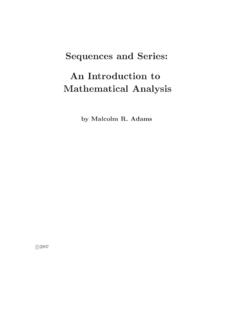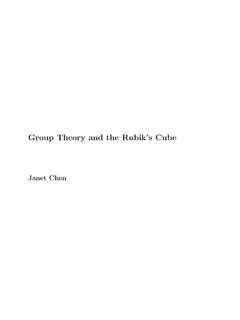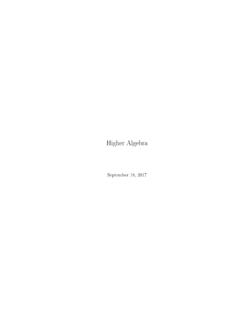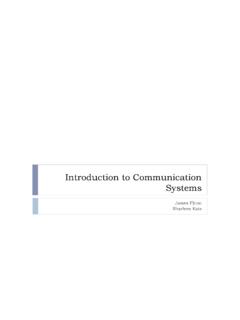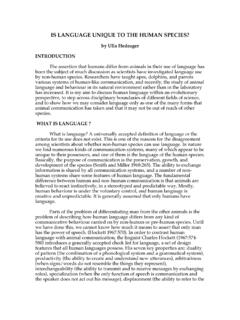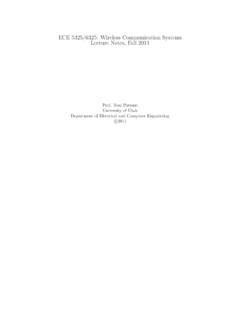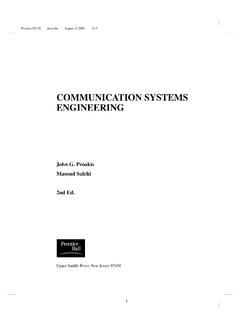Transcription of A Mathematical Theory of Communication
1 Reprinted with corrections fromThe Bell system Technical Journal,Vol. 27, pp. 379 423, 623 656, July, October, Mathematical Theory of CommunicationBy C. E. SHANNONINTRODUCTIONTHE recent development of various methods of modulation such as PCM and PPM which exchangebandwidth for signal-to-noise ratio has intensified the interest in a general Theory of Communication . Abasis for such a Theory is contained in the important papers of Nyquist1and Hartley2on this subject. In thepresent paper we will extend the Theory to include a number of new factors, in particular the effect of noisein the channel, and the savings possible due to the statistical structure of the original message and due to thenature of the final destination of the fundamental problem of Communication is that of reproducing at one point either exactly or ap-proximately a message selected at another point.
2 Frequently the messages havemeaning; that is they referto or are correlated according to some system with certain physical or conceptual entities. These semanticaspects of Communication are irrelevant to the engineering problem. The significant aspect is that the actualmessage is oneselected from a setof possible messages. The system must be designed to operate for eachpossible selection, not just the one which will actually be chosen since this is unknown at the time of the number of messages in the set is finite then this number or any monotonic function of this numbercan be regarded as a measure of the information produced when one message is chosen from the set, allchoices being equally likely.
3 As was pointed out by Hartley the most natural choice is the logarithmicfunction. Although this definition must be generalized considerably when we consider the influence of thestatistics of the message and when we have a continuous range of messages, we will in all cases use anessentially logarithmic logarithmic measure is more convenient for various reasons:1. It is practically more useful. Parameters of engineering importance such as time, bandwidth, numberof relays, etc., tend to vary linearly with the logarithm of the number of possibilities. For example,adding one relay to a group doubles the number of possible states of the relays. It adds 1 to the base 2logarithm of this number.
4 Doubling the time roughly squares the number of possible messages, ordoubles the logarithm, It is nearer to our intuitive feeling as to the proper measure. This is closely related to (1) since we in-tuitively measures entities by linear comparison with common standards. One feels, for example, thattwo punched cards should have twice the capacity of one for information storage, and two identicalchannels twice the capacity of one for transmitting It is mathematically more suitable. Many of the limiting operations are simple in terms of the loga-rithm but would require clumsy restatement in terms of the number of choice of a logarithmic base corresponds to the choice of a unit for measuring information.
5 If thebase 2 is used the resulting units may be called binary digits, or more brieflybits,a word suggested byJ. W. Tukey. A device with two stable positions, such as a relay or a flip-flop circuit, can store one bit devices can storeNbits, since the total number of possible states is 2 Nand log22N= the base 10 is used the units may be called decimal digits. Sincelog2M=log10M=log102=3:32 log10M;1 Nyquist, H., Certain Factors Affecting Telegraph Speed, Bell system Technical Journal,April 1924, p. 324; Certain Topics inTelegraph Transmission Theory , Trans.,v. 47, April 1928, p. , R. V. L., Transmission of Information, Bell system Technical Journal,July 1928, p. 1 Schematic diagram of a general Communication decimal digit is about 313bits.
6 A digit wheel on a desk computing machine has ten stable positions andtherefore has a storage capacity of one decimal digit. In analytical work where integration and differentiationare involved the baseeis sometimes useful. The resulting units of information will be called natural from the baseato basebmerely requires multiplication by a Communication system we will mean a system of the type indicated schematically in Fig. 1. Itconsists of essentially five parts:1. Aninformation sourcewhich produces a message or sequence of messages to be communicated to thereceiving terminal. The message may be of various types: (a) A sequence of letters as in a telegraphof teletype system ; (b) A single function of timef(t)as in radio or telephony; (c) A function oftime and other variables as in black and white television here the message may be thought of as afunctionf(x;y;t)of two space coordinates and time, the light intensity at point(x;y)and timeton apickup tube plate; (d) Two or more functions of time, sayf(t),g(t),h(t) this is the case in three-dimensional sound transmission or if the system is intended to service several individual channels inmultiplex; (e) Several functions of several variables in color television the message consists of threefunctionsf(x;y.)
7 T),g(x;y;t),h(x;y;t)defined in a three-dimensional continuum we may also thinkof these three functions as components of a vector field defined in the region similarly, severalblack and white television sources would produce messages consisting of a number of functionsof three variables; (f) Various combinations also occur, for example in television with an associatedaudio Atransmitterwhich operates on the message in some way to produce a signal suitable for trans-mission over the channel. In telephony this operation consists merely of changing sound pressureinto a proportional electrical current. In telegraphy we have an encoding operation which producesa sequence of dots, dashes and spaces on the channel corresponding to the message.
8 In a multiplexPCM system the different speech functions must be sampled, compressed, quantized and encoded,and finally interleaved properly to construct the signal. Vocoder systems, television and frequencymodulation are other examples of complex operations applied to the message to obtain the Thechannelis merely the medium used to transmit the signal from transmitter to receiver. It may bea pair of wires, a coaxial cable, a band of radio frequencies, a beam of light, Thereceiverordinarily performs the inverse operation of that done by the transmitter, reconstructingthe message from the Thedestinationis the person (or thing) for whom the message is wish to consider certain general problems involving Communication systems.
9 To do this it is firstnecessary to represent the various elements involved as Mathematical entities, suitably idealized from their2physical counterparts. We may roughly classify Communication systems into three main categories: discrete,continuous and mixed. By a discrete system we will mean one in which both the message and the signalare a sequence of discrete symbols. A typical case is telegraphy where the message is a sequence of lettersand the signal a sequence of dots, dashes and spaces. A continuous system is one in which the message andsignal are both treated as continuous functions, , radio or television. A mixed system is one in whichboth discrete and continuous variables appear, , PCM transmission of first consider the discrete case.
10 This case has applications not only in Communication Theory , butalso in the Theory of computing machines, the design of telephone exchanges and other fields. In additionthe discrete case forms a foundation for the continuous and mixed cases which will be treated in the secondhalf of the I: DISCRETE NOISELESS SYSTEMS1. THEDISCRETENOISELESSCHANNELT eletype and telegraphy are two simple examples of a discrete channel for transmitting information. Gen-erally, a discrete channel will mean a system whereby a sequence of choices from a finite set of elementarysymbolsS1;:::;Sncan be transmitted from one point to another. Each of the symbolsSiis assumed to havea certain duration in timetiseconds (not necessarily the same for differentSi, for example the dots anddashes in telegraphy).
